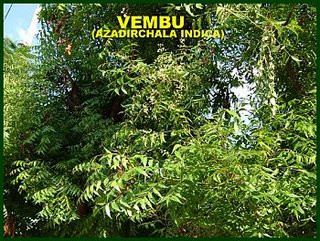The word Neem is derived from Sanskrit Nimba which means 'bestower of good health'. Neem or Margosa is a botanical cousin of mahogany and belongs to the family Meliaceae. The Latinized name of Neem, 'Azadirachta Indica' is derived from the Persian and literally means 'The Free Tree of India'. The name it goes by in Tamil Nadu is Vembu.
The Neem is a broad-leaved, evergreen tree which can grow up to 30m tall and 2.5m in girth. Its trunk is 30-80 cm in diameter. Its spreading branches form a rounded crown of deep-green leaves and honey-scented flowers as much as 20m across.

The tree which is known to cure many diseases, is a pest control agent as well as fertilizer. It is an intelligent pest repellent as it does not affect useful species only harmful pests. Furthermore because of its complex molecular structure pests do not become immune to it! The Neem releases more oxygen than other trees and thus is used in many areas to prevent desertification. It's completely safe and causes no harmful side-effects. It has also been used as a health and beauty aid in India for more than 5000 years!
This tree is found in abundant numbers throughout Tiruvannamalai District is the Neem tree holds an important place in Siddha and Ayurvedic medicine preparation. In fact the ancient Vedas called Neem 'sarva roga nivarini', which means 'one that cures all ailments and ills'.
The tree is considered to be of divine origin. According to Indian mythology, amrita (ambrosia or the elixir of immortality) was being carried to heaven and a few drops of it fell on the Neem tree. Another story tells of the time the Sun took refuge in the Neem Tree to escape from the awesome powers of the demons. Planting three or more Neem trees during one's lifetime was considered a surefire ticket to heaven!
No comments:
Post a Comment